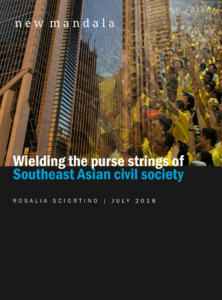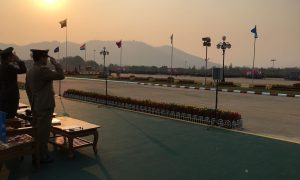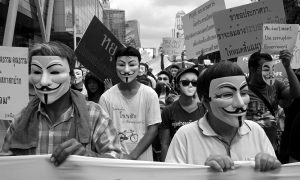Shrinking space, shrinking resources
As democracy experiences a global decline, and Southeast Asia oscillates between authoritarian endurance and democratic rollback, civil society in the region is facing a bleak future.
Dictatorships and quasi-democracies are racing to curtail freedom of speech and assembly and to subject civil society organisations (CSOs)—especially those advocating structural changes and human rights—to ever-tightening regulatory requirements. Traditionally viewed with suspicion by governments, and at times even by the public, as disruptors of societal order, increasingly CSOs’ legitimacy and accountability are questioned and their role and the effectiveness of their strategies contested.
The shrinking of civic space also affects (and is affected by) the availability of resources. Across Southeast Asia, governments’ stiffened oversight is limiting access to international and national funds by CSOs, in particular when directed at financing advocacy and rights-based activities. This occurs amidst an evolving development aid landscape wherein established donor agencies reposition themselves in line with more conservative contexts back home and abroad, and where a new set of funders does not necessarily appreciate the merit of a “vibrant civil society” for democracy and development.
This paper [download PDF here] singles out four factors as contributing to the financial “choking off” of civil society: greater government control of funding streams for CSOs; the reshaping of international aid spending globally and regionally; paradigmatic shifts in philanthropic giving; and scarce appreciation of civil society and advocacy work among local donors. While the interplay of these factors may differ per location, the general result is that civil society in Southeast Asia is losing its conventional backers, without finding the same level of support among alternative donors, affecting its ability to play a critical and transformative role.
Tightened government control
Governments in Southeast Asia have generally been apprehensive of CSOs challenging the status quo and uncomfortable with their mission of “safeguarding democracy, human rights and fundamental freedoms” and of “empowering” the marginalised. Only in the last few decades, and under the encouragement of international stakeholders, have they started to recognise CSOs’ contributions, albeit generally limited to their operational role in development programs. An exception has been the Philippines, where nongovernment organisations (NGOs) were already acknowledged in the Corporation Law in 1906, when the country was an American colony, and gained unprecedented prominence in the transition from dictatorship to democracy towards the end of the century. Uniquely in the region, the 1987 Philippine constitution affirms the societal contribution of non-profit entities, foresees financial support for organisations that promote social welfare and stipulates for them a range of fiscal exemptions.
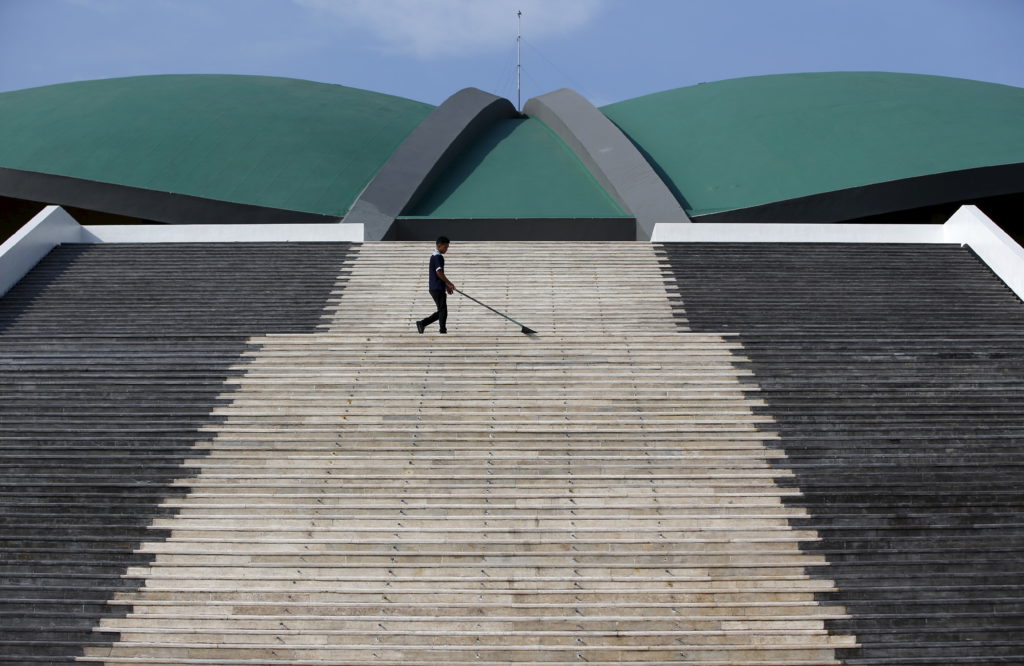
Worker at the Indonesian parliament building, 7 December 2015. REUTERS/Darren Whiteside
In the other Southeast Asian countries, regulations have focused on controlling more than enabling CSOs. The 2015 Index of Philanthropy Freedom found the region, and Asia more generally, to be below the global average in terms of ease of registering, financing and operating CSOs. Examples include Malaysia’s employment of security and counterterrorism laws against NGOs and their international donors, and the impossibility in Vietnam for advocacy and human rights organisations to register and thus to legitimately receive funding. Progress was only recorded in Myanmar thanks to the 2014 Association Registration Law that liberalised registration for CSOs.
Today, however, this window of opportunity in Myanmar is quickly closing, with increased oversight and bureaucratic hurdles, ostensibly introduced to enhance efficiency and prevent misuse of funding. More generally, governments across the region are tightening their already-restrictive measures to limit the ability of CSOs to function or to compel them to register and operate as apolitical for-profit enterprises.
Prominent in the growth of more-stick-than-carrot regulations are measures to control CSO resources. Governments in Southeast Asia, like in other conservative parts of the world, are be- coming more adept in employing financial tools for repressive purposes, from withholding public funds and limiting the type of CSO activities that can be funded, to taxing donations, requiring donors to register with state agencies and applying anti-money laundering, trafficking and, more recently, anti-terrorism financing measures at their discretion.
Government-backed grant-making foundations, a hybrid kind of institution consisting of public funding and semi-independent management with a significant presence in Southeast Asia, are at high risk of direct intervention. In 2016, Thailand’s government tightened its control of the Thai Health Promotion Foundation, the largest donor in the country, which is funded with tobacco revenues. Members of its board were sacked and granting rules revised, allegedly to enhance transparency and to meet the declared objectives, but actually reducing financing of transformative actions and of CSOs.
Heightened scrutiny is placed upon funding from foreign donors, “a particularly insidious means to narrow the space for civil society [… in] an environment where significant domestic funding for CSOs is absent” or minimal. Grantee organisations are vilified for being “foreign agents” paid to advocate a “Western agenda” dismissive of Asian values, and in extreme cases are accused of treason and criminalised.
In Laos, per November 2017, a new decree on non-profit associations and foundations requires CSOs to attain approval from the Ministry of Foreign Affairs before receiving foreign funds and assets. In Cambodia, NGOs are threatened by the enforcement of controversial obligations in the 2015 Law on Associations and NGOs (LANGO) to submit extensive financial and administrative data to the government.
Government-imposed constraints also affect funding streams at their source, impairing funders’ capacity to get out their support. Across Southeast Asia, past agreements and permission procedures for foreign donors and international NGOs (INGOs) to operate in various countries are being reviewed and there is greater examination of these institutions and the activities they are funding.
As generally risk-averse actors, multilateral and bilateral donors and larger INGOs are sensitive to local political climates and quickly adjust to government signals. Meanwhile, more independent foundations and smaller INGOs struggle to find new channels to continue supporting groups and causes now considered undesirable. Amid the increasing politicisation of religion in Indonesia, foreign funding for LGBT rights has diminished and gone underground following objections by senior politicians, officials and Islamist groups against the UNDP-led “Being LGBTI in Asia” initiative, which they claim is against national mores. Already, most donors will not touch “sensitive” issues, typically related to religious, ethnic and sexual diversity, after a regulation introduced in 2008 prohibited foreign funding for causes supposed to trigger “social anxiety”.
Regulatory changes in donors’ countries of origin also create hurdles, particularly those related to anti-terrorism securitisation measures. Bank procedures in the United States and Europe discourage opening foreign currency accounts and making international transfers. When not put off altogether, donors end up giving preference to using home institutions more accustomed to the rules as intermediaries, or placing more emphasis on due diligence and reporting—irrespective of local CSOs’ capacity to comply with the greater administrative burden. In the process, flexible funding, vital to CSOs in rapidly changing contexts, has become increasingly unattainable at a time when they can no longer count on donors “being there to build and support movements with core funding over many years” as the aid ecosystem is changing—and not only for regulatory or pragmatic reasons.
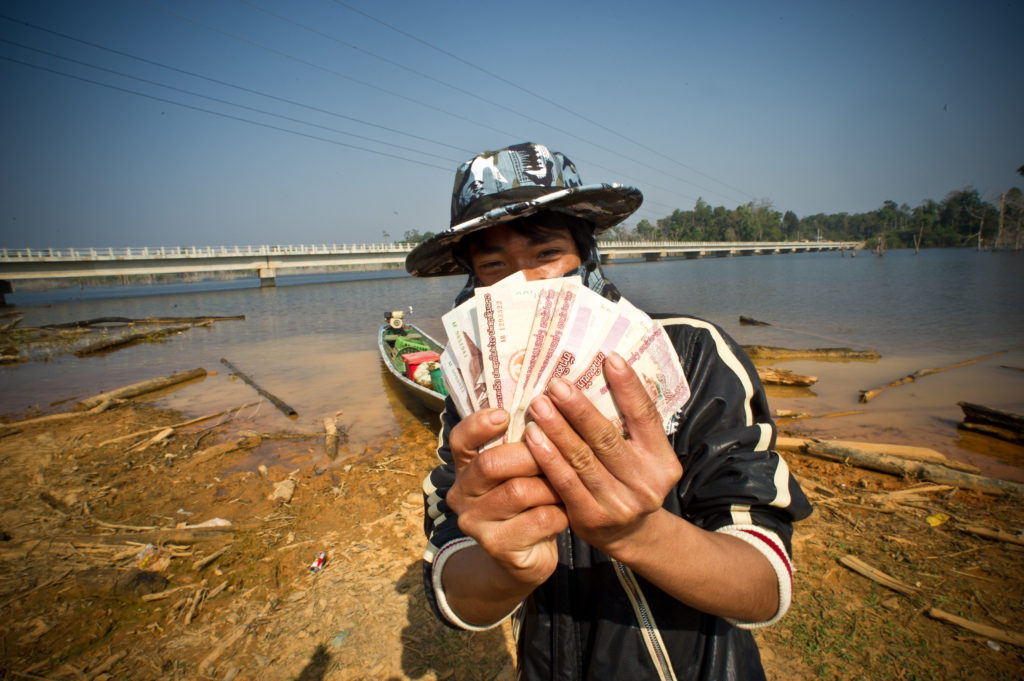
In this 2010 publicity photograph, a villager relocated as part of the Nam Theun 2 Hydropower Project in Laos shows earnings gained from an ADB-funded ‘livelihood training’ program. Asian Development Bank on Flickr, Creative Commons license.
A hostile aid landscape
The challenges to CSO resourcing are not limited to domestic political contexts. Multiple international trends in aid and philanthropy impact on the resourcing of civil society in Southeast Asia. To start with, funding opportunities for CSOs are declining as the overall amount of official development aid (ODA) from the Organisation for Economic Cooperation and Development (OECD) Development Assistance Committee (DAC) donor countries is being cut and diversely allocated.
After reaching a peak in 2010, ODA has been falling globally due to changing geopolitics and a waning appetite among conservative politicians and the public for overseas spending. Amidst austerity drives and protectionist rhetoric, aid has been instrumentalised and more firmly tied to the donor countries’ broader foreign policy, security, and commercial interests under the so-called “whole-of-government approach”. In the resulting prioritisation of foreign assistance, Southeast Asia as a whole has scored low, considered by some of its major donors (most of all the US, Europe and Canada, but most recently also Australia) to have lower strategic and economic value compared to other regions. Its fast growth has also been seen as a validation of its readiness to “graduate” from aid and used to justify reduced support, notwithstanding growing inequities, persistent vulnerabilities, and unresolved development challenges.
This scaling back and repositioning of foreign assistance has in turn implied a commercialisation of aid objectives, delivery systems, and development partners, which has correspondingly meant moving away from civil society and from the role envisioned for CSOs since the late 1980s. At that time, DAC donors started to provide official funding to the non-profit sector and enlisted INGOs in their countries to work overseas as a prerequisite for development programs, leading some to speak of an “NGO-isation of development aid”. While governments of the targeted countries remained the main ODA recipients in bilateral and multilateral initiatives, local civil society gradually started to be funded through INGOs, and to a lesser extent directly, in programs to reduce poverty and enhance people’s welfare, especially in disadvantaged areas, but also to foster good governance and redress gender, ethnic, and other structural biases.
The new millennium saw the global recognition at high-level international cooperation fora in Accra (2008), Busan (2011) and Mexico City (2014) of civil society as an “independent” force in development with a valuable role in advancing people’s rights. Unprecedented pledges were made by governments and their partners to create enabling conditions for CSOs to perform, including ensuring financial viability. Yet such repeated commitments have only partly materialised in Southeast Asia. The narrow interpretation of the principles of national ownership and coordination as emphasised in the 2005 Paris Declaration on Aid Effectiveness—effectively coming to mean “government ownership”—has affected CSOs’ independence by discouraging direct donor support and subordinating them as recipients of international funding via and as an “extension” of the government. Governments have now started to procure education, healthcare and other basic services from NGOs to enhance access to out of reach groups, although levels of such procurement are still low in Southeast Asia when compared to South and East Asia.
More fundamentally, the pro-CSO development paradigm is increasingly being challenged by the rise of pro-market ideologies and the closer integration of aid and trade, which encourage economic solutions and approaches in development. This is exemplified by current donor support to ASEAN to foster women’s empowerment, which emphasises women’s entrepreneurship and enterprises as instrumental to economic growth while placing less emphasis on supporting women rights’ groups, building feminist movements, changing cultural norms and enhancing women’s political participation to achieve gender equality.
At the global level, the United Nations’ 2030 Agenda for Sustainable Development, while acknowledging civil society’s contribution, gives an unprecedented role to the private sector “as an engine of economic growth and employment and a source of finance, technology and innovation” and trusts public–private partnerships for achieving sustainable development. In a newfound framework, reminiscent of early postcolonial modernisation endeavours, the trickle-down effect of economic growth is seen as the driver of sustainable development. In Southeast Asia, major donors like Australia’s Department of Foreign Affairs and Trade (DFAT) and the Asian Development Bank (ADB) have identified private sector development as a priority and allocated resources to this aim.
Through an expanding variety of income-generating financial instruments such as loans and investments, besides grants, aid is directed at nurturing and funding the private sector in low-to-middle income countries and at building a conducive environment for it. The new mission is fostering a “vibrant private sector”—rather than a “vibrant civil society”—of small and medium enterprises and socially responsible corporations, upon which sustainable development and trade performance is assumed to rest. Among donors, the hype is now for social enterprises: traditionally non-profit, but increasingly for-profit organisations that apply commercial strategies to attain social, environmental as well as financial outcomes.
In a parallel trend, calls for “boosting aid effectiveness” have dictated a streamlining of programs and the concentration of aid in large institutions with a global reach. Multi-stakeholder vertical funds, such as the Global Fund for AIDS, Tuberculosis and Malaria (GFATM) or funds managed by international development banks and other financial institutions, have mushroomed to channel a-priori earmarked funding to countries. More and more, private entities—trusted to be more “efficient” than the non-profit ones— are enlisted as “implementers” of foreign aid to help governments reach the set targets. In the resulting multi-layered aid industry of mainly private contractors and facilities and, to a diminishing extent, large INGOs and UN agencies, local NGOs are expected to bid for a project or respond to calls for proposals rather than initiate activities, and eventually employed as sub-contractors to deliver services on commission. In Southeast Asia, like in the rest of the world, changes in the development sector towards being “narrowly focused on short term results and values for money” is taking away resources and autonomy from civil society and compromising its ability to strive for social justice and transformation.
Contemporary Myanmar is a noteworthy example. Though it is one of the few countries in the region that is receiving an increasing amount of aid, opportunities are not benefiting critical CSOs. Before the recent political transition, international donors prioritised civil society and their human rights activities. Currently, however, larger top-down developmental projects seek implementing partners to deliver services. On their side—just as has happened in other Southeast Asian countries before—civic groups are becoming more technocratic and bureaucratic and acting less as a watchdog of corrupt government practices and vested business interests.
Yet even the diminished level of DAC donors’ engagement with civil society may still appear substantial when compared to the dismissive attitude of non-DAC countries operating in Southeast Asia—especially China, India, and Middle Eastern countries. Since these emerging donors are responsible for a growing aid share globally and in the region, their funding practices do not bode well for the future resourcing of NGOs and other CSOs. China’s denial of a development role for civil society matters the most due to its prominent and expanding reach. A latecomer to development assistance, since 2005 China has ramped up bilateral and regional aid along with loans from the Asian Infrastructure Investment Bank (AIIB) and other financial incentives under the Belt and Road Initiative (BRI), surpassing most traditional aid donor countries. Southeast Asia, due to its proximity to China, its ethnic Chinese diaspora, and its abundant natural resources, is a priority area for Chinese aid. Cambodia is among the top ten recipients of Chinese assistance, Laos among the top ten recipients of other official flows (OOF), and Myanmar and Indonesia are BRI priority countries for infrastructure projects.
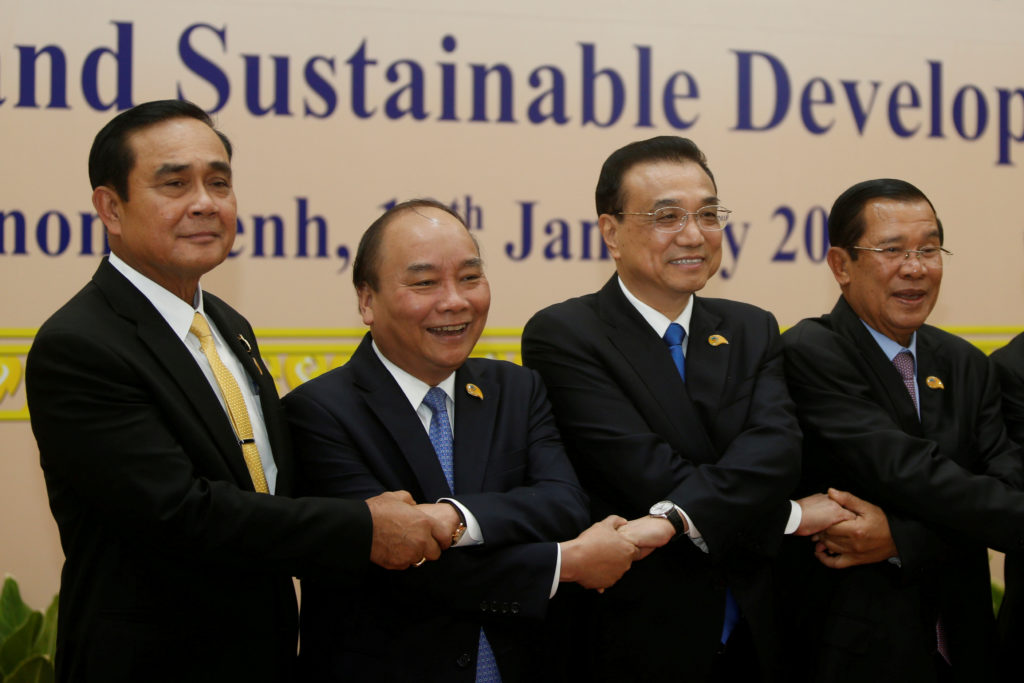
Chinese Premier Li Keqiang meets with Mainland Southeast Asian leaders in Phnom Penh, 10 January 2018. REUTERS/Samrang Pring
From the start, Chinese foreign aid has been heavily skewed towards economic measures, a blurring of aid and financial investments and loans, and delivery through private-sector or state-owned enterprises, with few socio-cultural projects and almost inexistent funding of NGOs. The ideological disjointing of economic growth from civil liberties and democracy, expressed in no-strings-attached and hand-off aid policies, is welcomed by increasingly authoritarian regimes, but clearly precludes a meaningful role for civil society.
Philanthropy and civil society: from foundation darlings to orphans?
Lower levels of aid funding for civil society in Southeast Asia are not being compensated for by the philanthropic flows that used to benefit CSOs the most, as international private foundations are also embracing less transformative approaches.
Historically, international foundations have sponsored the establishment and strengthening of civic institutions and movements in Southeast Asia much earlier and at a higher level than bilateral and multilateral donors. Beginning in the Cold War period, US foundations—foremost among these the Ford Foundation and the Rockefeller Foundation—engaged with countries in the region with the aim to assist them to “take off” on the development and democratisation path. Starting in the 1950s, the Rockefeller Foundation placed staff in local institutions and the Ford Foundation established country offices across the region with the idea that proximity was necessary to understand the context and to grant strategically. These examples were eventually followed by the Open Society Foundations with its offices and local foundations, such as the Tifa Foundation in Jakarta [Editor’s note: New Mandala is a recipient of a grant from the Tifa Foundation], and a number of Japanese and European foundations.
Early on, philanthropic foundations’ support facilitated the decolonisation of government institutions, strengthening incipient governance structures and public services. Inspired by the modernisation theory dominant at the time, top-down programs provided imported solutions, technology transfer, and foreign know-how. Western institutions were entrusted to build or strengthen local universities and educate the emerging national leadership in country and abroad, as well as to create a pool of technical personnel, teachers and administrators. INGOs, mainly from the US, were also funded to establish chapters or help build local organisations in the selected program areas such as population, health, agriculture and governance.
During the 1970s and 1980s, as international foundations adopted a more holistic and bottom-up paradigm, more and more NGOs were provided capacity building and long-term funding to address the social and cultural dimensions of development and to spearhead community programs in disadvantaged areas. By the 1990s the principles of “participation”, “empowerment” and “local ownership” were firmly established among international foundations and grants were directed to local organisations as the best positioned to find systemic and context-specific solutions to complex societal challenges, including fostering more open and accountable governments. Philanthropic funding supported both advocacy NGOs aiming for structural socio-cultural and political transformation and NGOs focusing on service delivery and community development.
As dictatorships came to an end and optimism about democracy bloomed in Thailand, the Philippines, and Indonesia, civil society mushroomed. International foundations, especially the Ford Foundation, Open Society Foundations and the publicly-supported German political foundations like the Heinrich Boell Stiftung and the Friedrich Ebert Foundation, funded a plethora of activities to raise awareness of human rights, women’s rights, and minority rights.
This social justice-oriented model of philanthropy was challenged in the early 2000s by the emergence of a new brand of foundations—including the Bill and Melinda Gates Foundation, the largest foundation ever with an endowment of US$40.3 billion in 2017, about double that of the Open Society Foundations [see disclosure above] and almost four times that of the Ford Foundation, respectively the second and third largest US private foundations that fund international causes—and the paradigm they proposed. In line with the thinking in development aid circles, the so-called venture philanthropy—or, more critically, “philanthrocapitalism”—reframes the modernisation discourse in globalisation terms, putting faith in the expansion of markets and innovations to drive worldwide development.
In this view, development is conceived as overcoming a knowledge deficit caused by a scarcity of resources, which requires technocratic and financial acumen rather than socio-cultural and political change. Efforts are therefore directed at the discovery of universal “magic bullets” that, if combined with adequate joint investment from foundations and the corporate sector, can be applied globally and lead to development results and monetary gains simultaneously. Focus is on attaining scientific progress in health and agriculture, with little appreciation of “soft” and less quantifiable fields of human rights, culture and the arts.
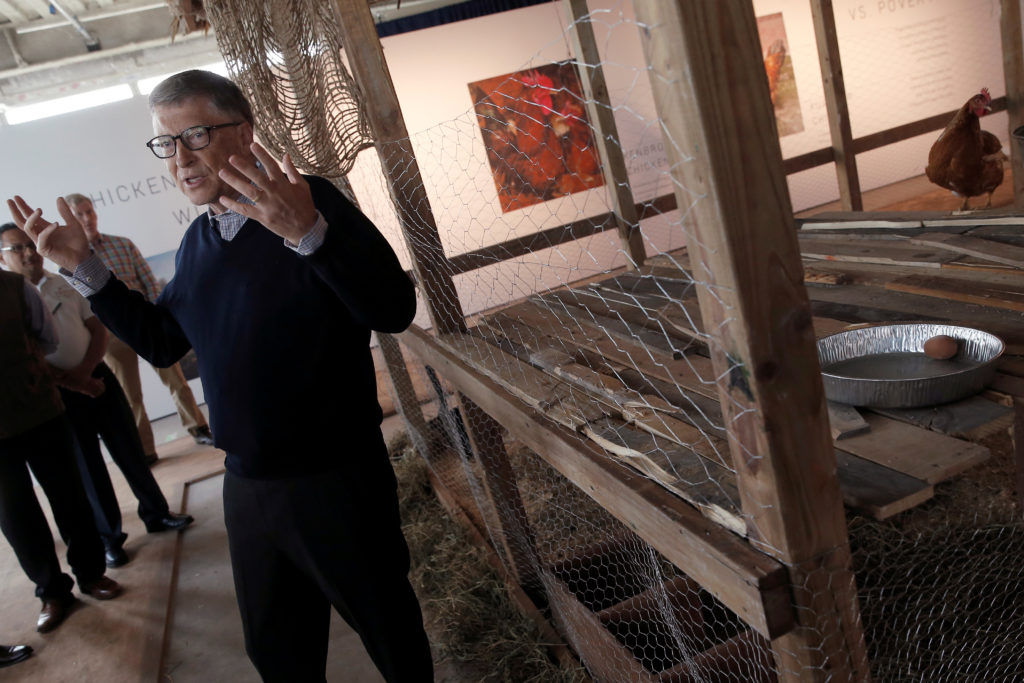
Bill Gates speaks to the media in New York, 8 June 2016, while announcing that he
is donating 100,000 chicks to developing countries with the goal of ending extreme poverty. REUTERS/Mike Sega
The decline of socially-engaged and contextual grant-making endangers the position of civil society as the primary partner of international foundations. New foundations privilege public–private partnerships and working with the private sector. When they involve NGOs, it is to deliver services with the expectation that they operate according to “entrepreneurial” principles. Like aid donors, they too are fond of social enterprises (especially if fully business ones) and have spearheaded “social impact investment” to sustain them and seek social benefits and financial returns. New foundations also focus more on Africa and emerging markets like India and China, and when they fund in Southeast Asia they do so through intermediaries. As an example, the Gates Foundation’s grant database shows limited grant-making to Southeast Asia and an almost total absence of local grantees for the limited activities funded in the Philippines, Indonesia, Thailand, and Cambodia.
Meanwhile the “traditional” US foundations, even when not fully subscribing to the technocratic paradigm, have modified their modus operandi and show less appreciation of local contexts and actors. Operations have been centralised in headquarters and with the notable exception of the Open Society [see disclosure above], field offices have been closed or reduced to logistic hubs. Most revealingly, of the many Ford Foundations offices in Southeast Asia only the Indonesia office remains open. This diminished presence implies also a shrunken budget for the countries in question and reduced direct funding to local organisations, and especially civil society, since no staff is there to identify smaller and less known groups among growing competition of potential recipients. With these and related changes in philanthropy, CSOs are at risk of becoming the “orphans” rather than being the “darlings” of international foundations as they used to be in the past.
The limits of local benefactors
Confronted with diminishing international resources, civil society has placed high hopes on being able to tap into home-grown philanthropy. At first sight, such hopes seem justified: in spite of a lack of national data (with the exception of Singapore), observers agree that the Southeast Asian philanthropic sector has undergone robust growth in the last two decades driven by the fast accumulation of wealth, greater societal pressure for corporate accountability, and a slightly more conducive policy environment. Individual donations remain the dominant form of giving, but indigenous foundations and other forms of institutionalised giving are growing throughout the region, bourgeoning in the richer countries of Singapore, Malaysia, Indonesia, Thailand, and the Philippines, and gradually emerging in the poorer countries. These new funding opportunities, however, have yet to translate into regular and sustainable support to civil society. As shown by my research examining philanthropic trends in Southeast Asia, home-grown philanthropy at this early stage of its development is generally not inclined towards social change approaches—and refrains from becoming involved with CSOs, especially if advocating human rights.
This is a reflection of the composition of the philanthropic sector as much as of the political environment in which it is embedded. Home-grown philanthropy is dominated by family corporate foundations and, even more commonly, corporate giving programs operated through informal or corporate channels. The number of independent private foundations, albeit increasing, remains relatively low. Intermingling of business interests and philanthropic objectives is rife, with giving tied to the family business and directed at enhancing its scope and reputation. The inclination is to work to advance social causes perceived as non-controversial and to support governments’ agendas in order to avoid potential conflicts that may eventually affect business interests. As Mark Sidel notes, “[i]t is rare in Asia for corporates to work on issues of social justice—a reticence, it must be noted, that is by no means confined to Asia”, but that is pervasive in authoritarian Southeast Asia.
This “risk-averse” corporate giving focuses on human development and service provision, with a majority of funding dedicated to education—especially the funding of academic buildings and fellowships—and to a lesser extent to medical care, including hospital buildings and treatment for underprivileged groups. Through their companies and Corporate Social Responsibility (CSR) programs, donors also contribute to community development in the areas surrounding company assets, and to ad hoc responses to disasters or community events. Support for arts and culture, human rights, gender issues and the environment is scant, although younger generations of philanthropists seem more interested in such causes. CSR activities do finance arts and culture partly to attain visibility for their brands, as is the case for tobacco-related foundations in Indonesia and other parts of the world.
In carrying out their missions, corporate family foundations mix grant-making with direct implementation and fundraising for their own program, thus reducing funding opportunities for resource-poor organisations. When they provide finances externally, they rarely consider proposals, and their preference is to give at their will to those they personally know in academic, business, or government circles. They generally mistrust non-profits, which they perceive as not transparent and accountable, and have enthusiastically adopted venture philanthropy with its emphasis on social enterprises and impact investment. CSOs may be funded to deliver services, but are at risk of seeing their funding cut if they engage in advocacy.
The same giving and beneficiary pattern also characterises the region’s faith-based institutions, albeit for different reasons. These precursors of institutionalised giving in Southeast Asia are far more numerous, and with greater resources and reach, compared to corporate initiatives. This is thanks to the cash and in-kind donations from individuals and families, and to a lesser extent income-generating assets and, increasingly, payments from social services.
In Indonesia, the Muslim zakat (Islamic tithing)-based organisation Dompet Dhuafa (DD) has become the country’s largest philanthropic organisation in terms of received donations, with a total of US$23 million in alms and zakat in 2017, of which more than two thirds were granted, used to implement programs or invested in social enterprise activities directly run by the foundation in the same year.
In their charity, faith-based institutions prioritise religious deeds and alleviating the suffering of the poor, the sick, orphans, migrants and other vulnerable groups. They also contribute to community development, provide humanitarian aid, deliver health, education and welfare services and undertake relief programs. But their humanitarian approach is often sectarian and rarely strives for structural change. Like their corporate counterparts they rarely engage in policy discussions and human rights issues and privilege NGOs that deliver services, rather than advocacy organisations.
Individual donors, meanwhile, do not seem comfortable with CSOs, and particularly not with advocacy organisations. When they donate to organisations rather than to individuals in their community—as is commonly the case—they give to religious institutions and social services. Research in the Philippines, Indonesia and Thailand shows that irrespective of the diverse majority faiths—Catholicism, Islam, and Buddhism respectively—only a tiny minority, fewer than 10%, gave to NGOs and even less to human rights organisations. Experiments are underway to educate the public about the contribution of CSOs to society and get them to support their causes. Most NGOs see value in broadening their donor base with crowd-funding and other electronic platforms for donations and try to form circles of “friends” who join in providing support. These and other innovations may provide a much sought alternative to seeking the support of corporate and faith-based support, but it is still too early to judge their success.
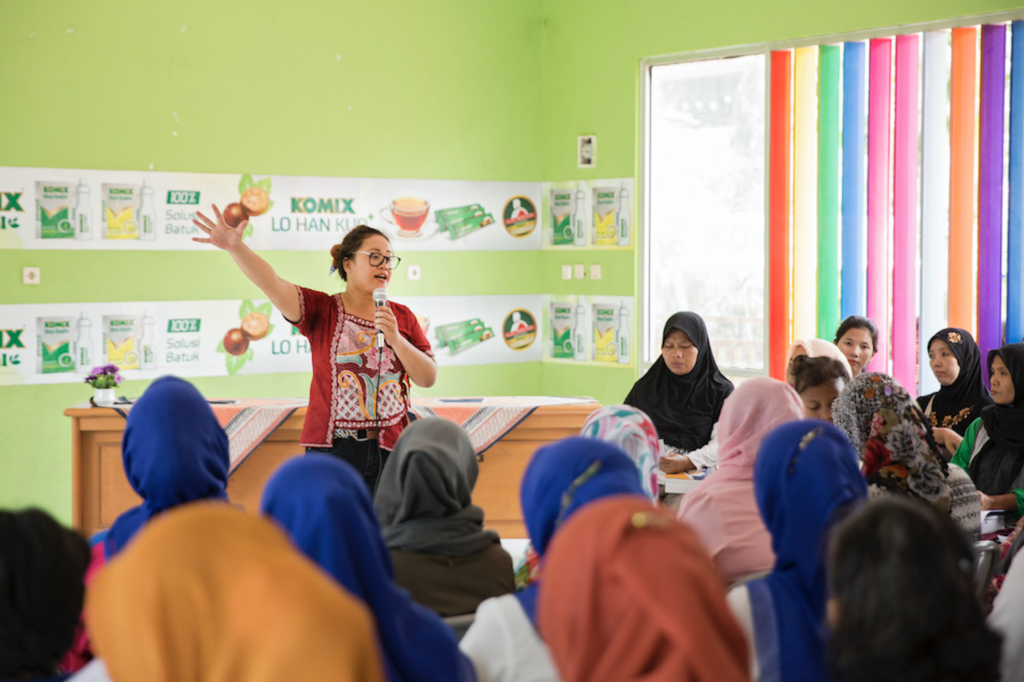
A community meeting held by NGO Kalyanamitra as part of the UN Women- supported Safe City pilot programme combating violence against women in Indonesia. UN Women on Flickr, Creative Commons licence.
Southeast Asia needs civil society, and civil society needs support
It would seem that for the time being at least, CSOs in Southeast Asia are confronted with the difficult choice of giving up their more political features in order to survive. The current funding landscape, shaped by conservative political forces and liberal market ideologies at home and abroad, has had not only implications for CSOs’ capacity and sustainability, but in Southeast Asia as in other parts of the world, is also skewing their profile and undermining their efforts to challenge the status quo. In the somewhat poetic words of Sriskandarajah, the secretary-general of the global civil society alliance Civicus, “the science of delivery has been strangling the art of social transformation”.
The collective dismissal of the advocacy function of CSOs has far reaching consequences, since there is no doubt that the upholding of humanistic and social justice ideals is still very much needed today. With the strengthening of fundamentalist and nationalist discourses, curtailment of basic freedoms, and growing socioeconomic disparities in the region, questions of equitable, inclusive, and democratic development are even more pressing.
These cannot be answered by only adding investments and technical know-how, or simply expanding access to services: they also require approaches that challenge entrenched powers and champion social change. The weakening of civil society and the re-emergence of authoritarian regimes in recent times should be seen as two sides of the same coin. If current threats to civic space are to be rebuked, a vibrant civil society composed of more than social delivery organisations is needed.
Considering that in the current climate it is not realistic to expect government support for advocacy CSOs, nor for them to be self-reliant or transform themselves all in social enterprises, a rethinking of development aid as well as a U-turn in international and local philanthropy are needed. If democratic regression and the undermining of civil society is to be halted, it is to be hoped that individual and institutional donors, both local and international, see the wisdom of ensuring more bold and socially-engaged funding.
 Facebook
Facebook  Twitter
Twitter  Soundcloud
Soundcloud  Youtube
Youtube  Rss
Rss 
